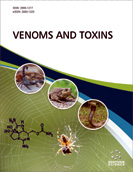- Home
- A-Z Publications
- Venoms and Toxins
- Previous Issues
- Volume 2, Issue 1, 2022
Venoms and Toxins - Volume 2, Issue 1, 2022
Volume 2, Issue 1, 2022
- Virology
-
-
-
Evaluation of Venom as a Promising Tool for Drug Discovery: Focusing on Neurological Disorders
More LessVenom toxins have specific molecular targets that result in envenomated complications such as neurotoxicity. During evolution, the composition of the venom has been evolved synchronously with the evolution of molecular targets. Venom is an important tool for humans from two different perspectives; venom advantages and disadvantages. Meanwhile, clinical and pharmacological applications of venoms due to their specif Read More
-
-
-
Toxins and Venoms from Marine Cnidarians and Gastropods: Diversity and Potential Drugs Targeting the Ion Channels
More LessAuthors: Sofiene Tlili, Raoua Ben Brahim, Jean-Marc Sabatier and Imed RegayaA diversity of marine invertebrates, such as cnidarians are rich sources of large bio-active molecules. This chemo-diversity of bio-active compounds has a promising potential in several biotechnological and therapeutic applications. On the basis of a comparative bibliographic approach, we intend in this review to present and discuss an overview of: i) the diversity of marine invertebrates as a candidate for bio-active molecules prod Read More
-
-
-
Bee Venom PLA2 versus Snake Venom PLA2: Evaluation of Structural and Functional Properties
More LessAuthors: Lara Bitar, Dania Jundia, Mohamad Rima, Jean-Marc Sabatier and Ziad FajlounPhospholipases A2 enzymes are found in many mammalian tissues and in animal venoms. Those present in bee venom (bvPLA2) and snake venom (svPLA2) have been studied more particularly for their biological activities of interest. Although they belong to the same family of secreted PLA2 (sPLA2), bvPLA2 and svPLA2 differ from a structural and functional point of view. In this review, we describe the morphological characte Read More
-
-
-
Top-down and Bottom-up Approaches Revealed New Categories of Peptides from the Venom of Moroccan Scorpion Androctonus mauretanicus
More LessBackground: Androctonus mauretanicus (Am ) is one of the most hazardous scorpions in Morocco and has a highly toxic venom responsible for severe cases of envenomation. However, few studies have focused on deciphering its proteic composition. Objectives: Herein, we aim to map out the complete proteome of the Am venom filtrate to highlight its complexity and the polymorphism of its toxic content. This, in turn, will l Read More
-
-
-
Cholera Toxin Induces Intestinal Secretion in an Acute Renal Failure Rat Model
More LessBackground: Cholera is a life-threatening secretory diarrheal disease caused by Vibrio cholera bacterium. On the contrary, local and specific use of cholera toxin (CT) at a low concentration can cause controlled fluid secretion. In the study, we explored the secretory action of CT in the intestine of rats with acute renal failure (ARF). Methods: Closed intestinal loop experiments were performed in ARF rats treated with CT. Secreted flu Read More
-
-
-
Design, Fabrication and Characterization of Nanoliposomes Containing Snake Venom of Pseudocerastes persicus
More LessBackground: The development of antivenom or antidote requires the repetition of immunization of large animals, such as horses and goats, which ultimately releases the IgG immunoglobulin produced in the serum specimen. As snake venom involves a variety of proteins and enzymes getting administered into the animal, this process can inflict significant harm to the animal; therefore, choosing carriers that can deliver the lea Read More
-
-
-
Detection of Enterotoxin Genes in Bacillus species Isolated from Cassava Processing Environment in Nigeria
More LessAuthors: Nkem Torimiro, Oluwafemi B. Daramola, Richard K. Omole and Ifeyimika Z. AdesinaIntroduction: The health challenges associated with cassava products as a common staple food for approximately 70 % of Africans and part of Asia pose a looming danger due to Bacillus enterotoxins’ presence in the processing environment. Objective: This study investigated the presence of enterotoxigenic genes, namely, Bacillus cereus enterotoxin T (bceT), hemolysin bl (hblC, hblD), and non-haemolytic enterotoxin (nheA, n Read More
-
Volumes & issues
Most Read This Month
Article
content/journals/vat
Journal
10
5
false
en


